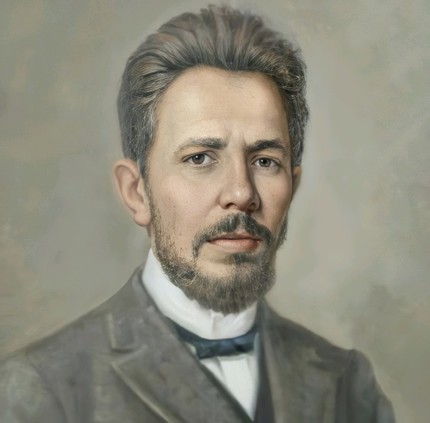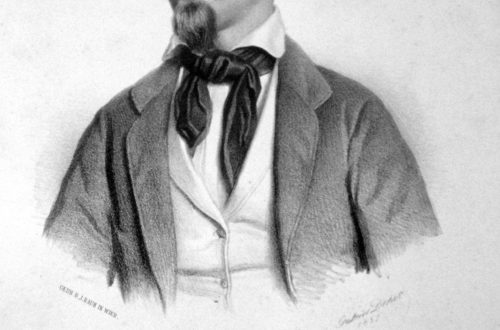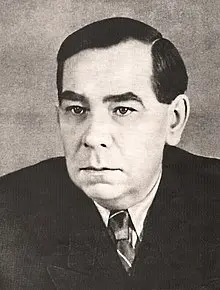
Vasily Sergeevich Kalinnikov |
Vasily Kalinnikov

… I was blown away by the charm of something dear, very familiar … A. Chekhov. “House with mezzanine”
V. Kalinnikov, a talented Russian composer, lived and worked in the 80s and 90s. XNUMXth century It was the time of the highest rise of Russian culture, when P. Tchaikovsky created his last masterpieces, operas by N. Rimsky-Korsakov, works by A. Glazunov, S. Taneyev, A. Lyadov appeared one after another, early compositions by S. Rachmaninov appeared on the musical horizon , A. Scriabin. Russian literature of that time shone with such names as L. Tolstoy, A. Chekhov, I. Bunin, A. Kuprin, L. Andreev, V. Veresaev, M. Gorky, A. Blok, K. Balmont, S. Nadson … And in this mighty stream sounded the modest, but surprisingly poetic and pure voice of Kalinnikov’s music, which immediately fell in love with both the musicians and the audience, subdued by sincerity, cordiality, inescapably Russian melodic beauty. B. Asafiev called Kalinnikov “Ring Ring of Russian Music”.
A sad fate befell this composer, who died in the prime of his creative powers. “For the sixth year I have been struggling with consumption, but she defeats me and slowly but surely takes over. And it’s all the fault of the damned money! And it happened to me to get sick from those impossible conditions in which I had to live and study.
Kalinnikov was born into a poor, large family of a bailiff, whose interests differed sharply from the mores of a provincial province. Instead of cards, drunkenness, gossip – healthy everyday work and music. Amateur choral singing, song folklore of the Oryol province were the first musical universities of the future composer, and the picturesque nature of the Oryol region, so poetically sung by I. Turgenev, nourished the boy’s imagination and artistic imagination. As a child, Vasily’s musical studies were supervised by the zemstvo doctor A. Evlanov, who taught him the basics of musical literacy and taught him to play the violin.
In 1884, Kalinnikov entered the Moscow Conservatory, but a year later, due to lack of funds to pay for his studies, he moved to the Music and Drama School of the Philharmonic Society, where he could study for free in the wind instrument class. Kalinnikov chose the bassoon, but he paid most of his attention to the harmony lessons taught by S. Kruglikov, a versatile musician. He also attended lectures on history at Moscow University, performed in obligatory opera performances and philharmonic concerts for school students. I also had to think about making money. In an effort to somehow alleviate the financial situation of the family, Kalinnikov refused financial assistance from home, and in order not to die of hunger, he earned money by copying notes, penny lessons, playing in orchestras. Of course, he got tired, and only his father’s letters supported him morally. “Immerse yourself in the world of musical science,” we read in one of them, “work … Know that you will face difficulties and failures, but do not weaken, fight them … and never back down.”
The death of his father in 1888 was a heavy blow for Kalinnikov. The first works – 3 romances – went out of print in 1887. One of them, “On the old mound” (at I. Nikitin station), immediately became popular. In 1889, 2 symphonic debuts took place: in one of the Moscow concerts, Kalinnikov’s first orchestral work was successfully performed – the symphonic painting “Nymphs” based on the plot of Turgenev’s “Poems in Prose”, and at the traditional act at the Philharmonic School he conducted his Scherzo. From this moment on, orchestral music acquires the main interest for the composer. Brought up on the song and choral traditions, not having heard a single instrument until the age of 12, Kalinnikov is increasingly attracted to symphonic music over the years. He believed that “music … is, in fact, the language of moods, that is, those states of our soul that are almost inexpressible in words and cannot be described in a certain way.” Orchestral works appear one after another: Suite (1889), which won Tchaikovsky’s approval; 2 symphonies (1895, 1897), symphonic painting “Cedar and Palm Tree” (1898), orchestral numbers for A. K. Tolstoy’s tragedy “Tsar Boris” (1898). However, the composer also turns to other genres – he writes romances, choirs, piano pieces, and among them the “Sad Song” beloved by everyone. He takes up the composition of the opera “In 1812”, commissioned by S. Mamontov, and completes the prologue to it.
The composer enters the period of the highest flowering of his creative forces, but it is at this time that the tuberculosis that opened a few years ago begins to progress. Kalinnikov staunchly resists the disease that devours him, the growth of spiritual forces is directly proportional to the fading of physical forces. “Listen to the music of Kalinnikov. Where is the sign in it that these poetic sounds poured out in the full consciousness of a dying person? After all, there is no trace of groans or illness. This is healthy music from beginning to end, sincere, lively music … ”wrote the music critic and friend of Kalinnikov Kruglikov. “Sunny soul” – this is how contemporaries spoke about the composer. His harmonic, balanced music seems to radiate a soft warm light.
Particularly remarkable is the First Symphony, which evokes the inspired pages of Chekhov’s lyrical-landscape prose, Turgenev’s rapture with life, nature, and beauty. With great difficulty, with the help of friends, Kalinnikov managed to achieve the performance of the symphony, but as soon as it sounded for the first time in a concert of the Kyiv branch of the RMS in March 1897, its triumphant procession through the cities of Russia and Europe began. “Dear Vasily Sergeevich!” – Conductor A. Vinogradsky writes to Kalinnikov after the performance of the symphony in Vienna. “Your symphony also won a brilliant victory yesterday. Indeed, this is some kind of triumphal symphony. Wherever I play it, everyone likes it. And most importantly, both the musicians and the crowd.” A brilliant success also fell to the lot of the Second Symphony, a bright, life-affirming work, written widely, on a grand scale.
In October 1900, 4 months before the composer’s death, the score and clavier of the First Symphony were published by Jurgenson’s publishing house, bringing much joy to the composer. The publisher, however, did not pay the author anything. The fee he received was a hoax of friends who, together with Rachmaninov, collected the necessary amount by subscription. In general, for the last few years Kalinnikov had been forced to exist solely on the donations of his relatives, which for him, very scrupulous in money matters, was an ordeal. But the ecstasy of creativity, faith in life, love for people somehow raised him above the dull prose of everyday life. A modest, persistent, benevolent person, a lyricist and a poet by nature – this is how he entered the history of our musical culture.
O. Averyanova





